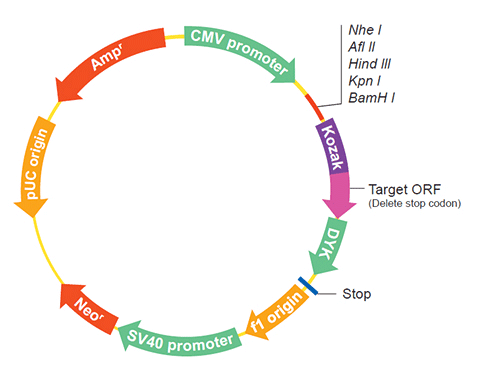| Gene Symbol | LOC101732009 |
| Entrez Gene ID | 101732009 |
| Full Name | RRP12-like protein |
| Gene Type | protein-coding |
| Organism | Xenopus tropicalis(tropical clawed frog) |
HOME
ORF » Species Summary » Xenopus tropicalis » LOC101732009 cDNA ORF clone
| Gene Symbol | LOC101732009 |
| Entrez Gene ID | 101732009 |
| Full Name | RRP12-like protein |
| Gene Type | protein-coding |
| Organism | Xenopus tropicalis(tropical clawed frog) |
| mRNA | Protein | Name |
|---|---|---|
| XM_018095774.1 | XP_017951263.1 | RRP12-like protein |


Generation and initial analysis of more than 15,000 full-length human and mouse cDNA sequences.
Strausberg RL, Feingold EA, Grouse LH, Derge JG, Klausner RD, Collins FS, Wagner L, Shenmen CM, Schuler GD, Altschul SF, Zeeberg B, Buetow KH, Schaefer CF, Bhat NK, Hopkins RF, Jordan H, Moore T, Max SI, Wang J, Hsieh F, Diatchenko L, Marusina K, Farmer AA, Rubin GM, Hong L, Stapleton M, Soares MB, Bonaldo MF, Casavant TL, Scheetz TE, Brownstein MJ, Usdin TB, Toshiyuki S, Carninci P, Prange C, Raha SS, Loquellano NA, Peters GJ, Abramson RD, Mullahy SJ, Bosak SA, McEwan PJ, McKernan KJ, Malek JA, Gunaratne PH, Richards S, Worley KC, Hale S, Garcia AM, Gay LJ, Hulyk SW, Villalon DK, Muzny DM, Sodergren EJ, Lu X, Gibbs RA, Fahey J, Helton E, Ketteman M, Madan A, Rodrigues S, Sanchez A, Whiting M, Madan A, Young AC, Shevchenko Y, Bouffard GG, Blakesley RW, Touchman JW, Green ED, Dickson MC, Rodriguez AC, Grimwood J, Schmutz J, Myers RM, Butterfield YS, Krzywinski MI, Skalska U, Smailus DE, Schnerch A, Schein JE, Jones SJ, Marra MA,
Proceedings of the National Academy of Sciences of the United States of America99(26)16899-903(2002 Dec)
GeneRIFs: Gene References Into Functions What's a GeneRIF?
The following LOC101732009 gene cDNA ORF clone sequences were retrieved from the NCBI Reference Sequence Database (RefSeq). These sequences represent the protein coding region of the LOC101732009 cDNA ORF which is encoded by the open reading frame (ORF) sequence. ORF sequences can be delivered in our standard vector, pcDNA3.1+/C-(K)DYK or the vector of your choice as an expression/transfection-ready ORF clone. Not the clone you want? Click here to find your clone.
| CloneID | OXa45705 | |
| Clone ID Related Accession (Same CDS sequence) | XM_018095774.1 | |
| Accession Version | XM_018095774.1 Latest version! | Documents for ORF clone product in default vector |
| Sequence Information | ORF Nucleotide Sequence (Length: 3804bp) Protein sequence SNP |
|
| Vector | pcDNA3.1-C-(k)DYK or customized vector |  User Manual User Manual |
| Clone information | Clone Map |  MSDS MSDS |
| Tag on pcDNA3.1+/C-(K)DYK | C terminal DYKDDDDK tags | |
| ORF Insert Method | CloneEZ™ Seamless cloning technology | |
| Insert Structure | linear | |
| Update Date | 2016-09-07 | |
| Organism | Xenopus tropicalis(tropical clawed frog) | |
| Product | RRP12-like protein | |
| Comment | Comment: MODEL REFSEQ: This record is predicted by automated computational analysis. This record is derived from a genomic sequence (NC_030683.1) and transcript sequence (BC074635.1) annotated using gene prediction method: Gnomon, supported by mRNA and EST evidence. Also see: Documentation of NCBI's Annotation Process ##Genome-Annotation-Data-START## Annotation Provider :: NCBI Annotation Status :: Full annotation Annotation Version :: Xenopus tropicalis Annotation Release 103 Annotation Pipeline :: NCBI eukaryotic genome annotation pipeline Annotation Software Version :: 7.1 Annotation Method :: Best-placed RefSeq; Gnomon Features Annotated :: Gene; mRNA; CDS; ncRNA ##Genome-Annotation-Data-END## ##RefSeq-Attributes-START## assembly gap :: added 79 transcript bases to patch genome assembly gap ##RefSeq-Attributes-END## | |
1 | ATGGGGAAGG CAGGGAAATT GCGCTCCGGT TCTGCCGGGA AAAGCAAGCG CTGGAAGAAG |
The stop codons will be deleted if pcDNA3.1+/C-(K)DYK vector is selected.
| RefSeq | XP_017951263.1 |
| CDS | 253..4056 |
| Translation |

Target ORF information:
Target ORF information:
|
 XM_018095774.1 XM_018095774.1 |

1 | ATGGGGAAGG CAGGGAAATT GCGCTCCGGT TCTGCCGGGA AAAGCAAGCG CTGGAAGAAG |
The stop codons will be deleted if pcDNA3.1+/C-(K)DYK vector is selected.
Generation and initial analysis of more than 15,000 full-length human and mouse cDNA sequences. |